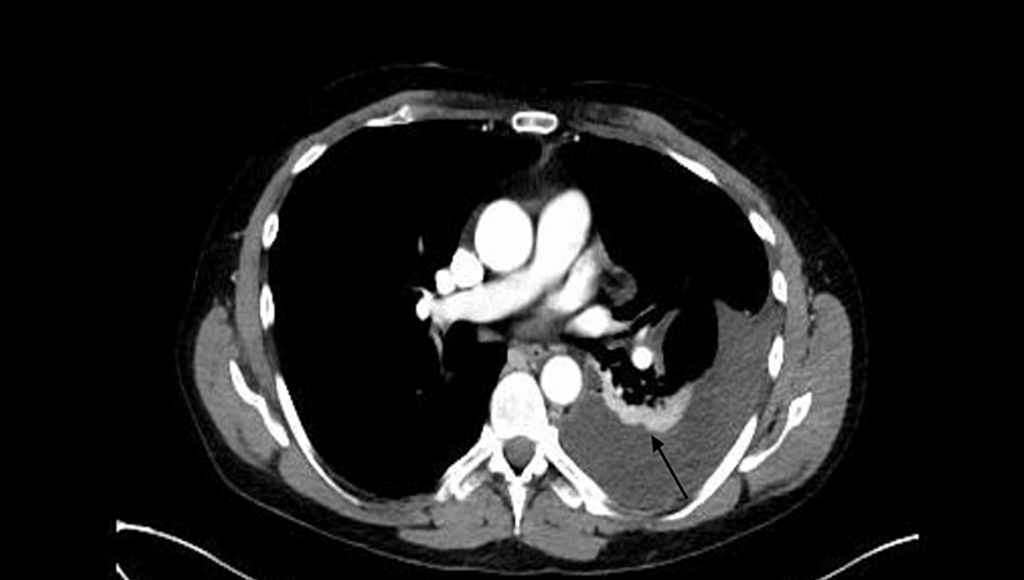Ehlers-Danlos syndrome (EDS) is a rare genetic disorder affecting collagen production, leading to abnormalities in connective tissues. This condition manifests with distinctive features such as skin hyperextensibility, joint hypermobility, and increased susceptibility to bruising 1. This article delves into an intriguing case involving a middle-aged male with EDS who experienced recurrent hemothorax following the administration of sildenafil, a phosphodiesterase five (PDE-5) inhibitor commonly prescribed for erectile dysfunction, via an online prescription service 2.
The patient’s decision to seek sildenafil through online channels underscores the growing trend of virtual healthcare accessibility 3. However, the consequences proved severe, as the individual suffered a hemothorax shortly after sildenafil ingestion 2. PDE-5 inhibitors, including sildenafil, have been associated with adverse vascular events such as intraluminal tears and have shown a concerning correlation with aortic dissection, particularly in men 4.
A hemothorax, characterized by blood accumulation in the pleural cavity between the chest wall and lung surface, typically arises from chest trauma but can also stem from underlying medical conditions affecting blood clotting or vessel integrity 5. This case presents a unique scenario where sildenafil, a medication not traditionally linked with hemothorax, triggered this complication in a patient with EDS, shedding light on the potential risks associated with online prescription services and underlying genetic predispositions1.
Other Incidents Linked to PDE-5 Inhibitor Usage
- In 2012, a case report detailed the experience of a 63-year-old man with hypertension who arrived at the emergency room with chest pain 20 hours after consuming tadalafil, a PDE-5 inhibitor. Subsequent evaluation revealed a type B dissection of his descending thoracic aorta 6.
- Similarly, a 61-year-old man with hypertension and atrial fibrillation exhibited a type A aortic dissection just 30 minutes after taking sildenafil. Notably, type B aortic dissections have been documented following the combined use of cocaine and sildenafil 7.
These cases, alongside the present instance, underscore an observed association between phosphodiesterase inhibitors and vascular injury. A common thread among these occurrences is a predisposition to vessel fragility. While this instance attributes the complication to the underlying Ehlers-Danlos syndrome, other cases implicate factors such as hypertension and cocaine usage, all of which can predispose blood vessels to tears. Despite these notable associations, there remains a dearth of data concerning adverse reactions to phosphodiesterase inhibitors among individuals with Ehlers-Danlos syndrome.
The Dangers of Online Prescriptions: Case Presentation 2
Patient Background:
- Male in mid-40s with Ehlers-Danlos syndrome.
- History of bilateral carotid dissection, bilateral iliac artery dissections, and spontaneous pneumothorax.
Hospital Admission:
- Presented with acute onset chest pain after sexual intercourse.
- CT scan revealed moderate left-sided pleural effusion with concern for hemothorax.
- Left-sided pigtail catheter placement confirmed diagnosis of hemothorax.
- Discharged home after chest tube removal.

Figure 1: Chest computed tomography demonstrating a large left pleural effusion
Medication History:
- Taking atorvastatin 80 mg and pantoprazole 40 mg daily.
- Reported taking one 40 mg dose of sildenafil before chest pain.
- Obtained sildenafil prescription from telemedicine service.
Follow-up Care:
- Developed progressive cough and left chest wall pain post-discharge.
- A primary care provider advised stopping sildenafil after a recurrence of pleural effusion.
- Further evaluation in the emergency department.
Emergency Department Findings:
- Vital signs: temperature 99.6 F, heart rate 117, blood pressure 120/66, respiratory rate 18, oxygen saturation 98%.
- Physical examination showed decreased lung sounds at the base of the left lung.
- Labs revealed normocytic anemia (hemoglobin: 10.4 g/dL).
- Chest CT showed a large left pleural effusion with evolving subacute/chronic blood products.
Treatment and Surgery:
- Underwent left video-assisted thoracoscopic surgery (VATS) for fluid analysis and pleural biopsy.
- Pleural fluid culture and pathology confirmed diagnosis of hemothorax.
- Admitted to cardiothoracic surgery service and discharged after chest tube removal.
Follow-up Care and Recovery:
- Follow-up appointments with primary care physician and vascular surgeon.
- Resolved cough and chest pain, no pleural effusion or hemothorax recurrence on follow-up chest X-ray.
- Discontinued sildenafil use, able to return to work and normal lifestyle without complications.

Figure 2: Follow-up chest X-ray with resolution of left-sided hemothorax
Discussion 2,3,4
Online prescription services seem convenient for obtaining medication but have limitations. There are three types of online prescription services: online pharmacies, websites with doctors and pharmacists, and online drug shops. However, the latter is considered illegal by most law enforcement agencies. Traditional doctor-patient interactions have advantages over online prescribing, such as discussing patients’ medical history, current health problems, and physical examination. There have been cases of complications arising from online prescription services, including a link between PDE-5 inhibitors and vascular complications. Patients with risk factors affecting vasculature are at a higher risk of detrimental complications. Practitioners and patients need to adapt to the changing world, and some states have adopted telemedicine guidelines to address these issues.
Conclusion 2,3,4
Healthcare providers must establish a strong doctor-patient relationship through a detailed history and physical examination before prescribing new medications. A recent case highlighted the potential negative side effects of prescribing a phosphodiesterase inhibitor to a patient with Ehlers-Danlos syndrome. In some cases, this connective tissue disorder has been associated with vessel fragility and adverse outcomes. Therefore, it is important to exercise caution when prescribing phosphodiesterase inhibitors to patients with connective tissue disorders. While telemedicine has become increasingly important in our changing clinical world, it should not replace in-person visits, particularly in cases involving patients with complex medical problems.
References
- Miklovic T, Sieg VC. Ehlers-Danlos Syndrome [Internet]. PubMed. Treasure Island (FL): StatPearls Publishing; 2024 [cited 2024 Mar 6]. Available from: https://www.ncbi.nlm.nih.gov/books/NBK549814/?utm_medium=email&utm_source=transaction
- Varkey A, Killian K, Melnick J. An Unusual Case of Hemothorax in an Ehlers-Danlos Syndrome Patient Following Sildenafil Use. February 27, 2024. Cureus 16(2): e55084. doi:10.7759/cureus.55084
- Haleem A, Javaid M, Singh RP, et al. Telemedicine for healthcare: capabilities, features, barriers, and applications. Sens Int. 2021, 2:10.1016/j.sintl.2021.100117
- Balestra M: Telehealth and legal implications for nurse practitioners. J Nurse Pract. 2018, 14:33-9. 10.1016/j.nurpra.2017.10.003
- Pumarejo Gomez L, Tran VH: Hemothorax. StatPearls [Internet]. StatPearls Publishing, Treasure Island (FL); 2023.
- Lameijer CM, Tielliu IF, van Driel MF, et al. Type B aortic dissection after the use of tadalafil. Ann Thorac Surg. 2012, 93:651-3. 10.1016/j.athoracsur.2011.07.016
About Docquity
If you need more confidence and insights to boost careers in healthcare, expanding the network to other healthcare professionals to practice peer-to-peer learning might be the answer. One way to do it is by joining a social platform for healthcare professionals, such as Docquity.
Docquity is an AI-based state-of-the-art private & secure continual learning network of verified doctors, bringing you real-time knowledge from thousands of doctors worldwide. Today, Docquity has over 400,000 doctors spread across six countries in Asia. Meet experts and trusted peers across Asia where you can safely discuss clinical cases, get up-to-date insights from webinars and research journals, and earn CME/CPD credits through certified courses from Docquity Academy. All with the ease of a mobile app available on Android & iOS platforms!






